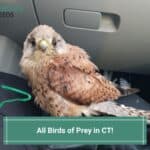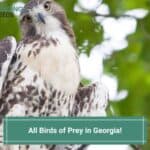
Are you searching for a guide to help you identify birds of prey in Kansas?
In this article, we’ve discussed the identifying features of 13 raptors to help you identify your favorite birds when you go birdwatching!
Kansas, “the Sun Flower State,” is home to fascinating birdlife that is a testament to the wonder of the state’s natural beauty.
Moreover, its ideal geographical location places the state in the center of North America with many habitats that can house a diverse birdlife. These include deciduous and mixed forests, grasslands, wetlands, and more.
So, if you’re on a mission to go birdwatching, Kansas is the place to be.
Some birds of prey found in Kansas stay in the state year-round, whereas others are temporary guests that are only seen during the breeding season or migration in specific seasons.
Let’s look at some of the common and uncommon birds in the great state of Kansas:
Before you scroll further down this guide, check out these other animal-related articles: Best French Bulldog Breeders in Kansas and Ferrets for Sale in Kansas City.
Table of Contents
1. Harris’s Hawk
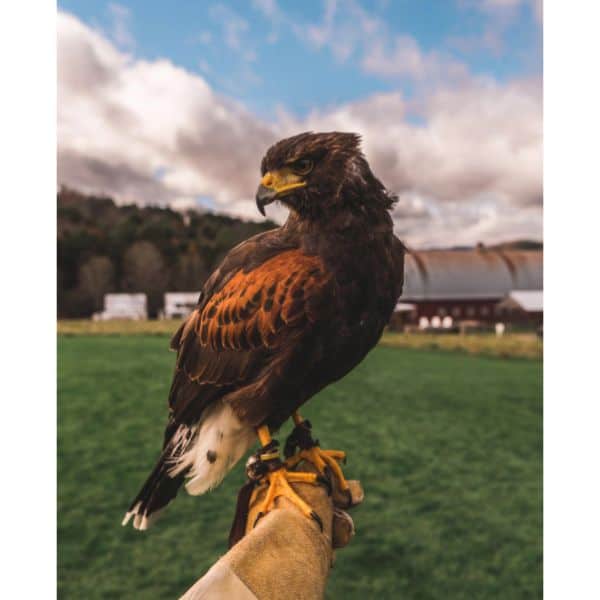
Harris’s Hawk Characteristics:
- Scientific Name: Parabuteo unicinctus
- Length: 18.1-23.2 in (46-59 cm)
- Weight: 18.2-31.0 oz (515-880 g)
- Wingspan: 40.5-46.9 in (103-119 cm)
The Harris’s Hawk is also known as the bay-winged hawk, wolf hawk, and dusty hawk.
The Harris’s Hawk body color makes it relatively easy to identify; the bird has dark brown plumage and is considered large in size, especially for a Hawk.
The shoulders, thighs, and wingtips are chestnut, whereas the tail, particularly its base and tip, are white, whereas the legs and cere of Harris’s hawk are bright yellow.
This hawk usually has small mammals for meals; even carrion is consumed, if available.
When it comes to a bird’s call, it tends to sound angry and aggressive.
It gives out a jarring call, lasting about 3-4 seconds, especially when intruders are near a kill site or to protect and defend its territory.
Harris’s Hawks inhibit sparse woodlands, savannahs, semi-deserts, and marshes. Their territory also includes high perches among trees and power poles.
2. Red-Shouldered Hawk
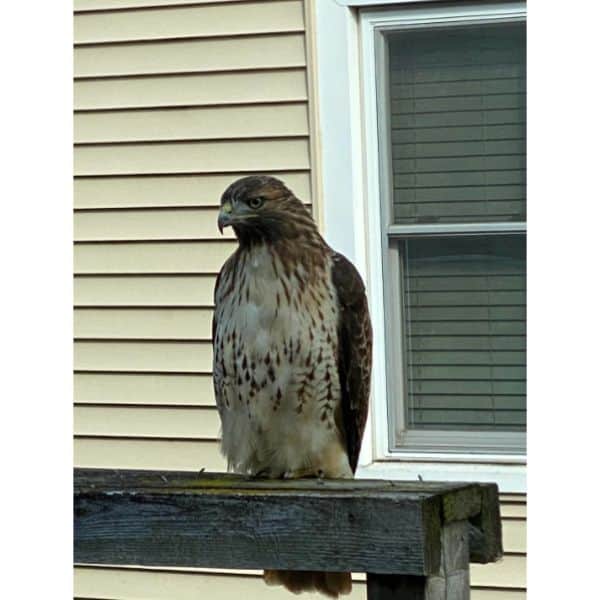
Red-Shouldered Hawk Characteristics:
- Scientific Name: Buteo Lineatus
- Length: 16.9-24.0 in (43-61 cm)
- Weight: 17.1-27.3 oz (486-774 g)
- Wingspan: 37.0-43.7 in (94-111 cm)
The Red-Shouldered Hawk is a year-round Kansas resident found near the Eastern border.
Brown head, red chest, and pale-shaded belly with red-like barring, the Red-shouldered Hawk is a bird with looks.
This hawk has red patches on its wrists and upper back; this makes the hawk’s shoulders appear red; hence, it’s given the name of a red-shouldered hawk.
The wings are crescent-shaped, often appearing translucent.
The Red-shouldered Hawk has a small, hooked beak, and its tail is fairly long. It enjoys a diverse and unique diet.
The bird consumes several types of prey, ranging from mammals, birds, reptiles, and amphibians.
However, it commonly feeds on small mammals like chipmunks and voles in North America.
The Red-shouldered Hawk has a high-note and clear call, a 3-syllable call that sounds like “kee-ann-err” or may be shortened to “kee-err.”
The hawk will give out this call continuously, often announcing that its territory is occupied or declaring it is in defense mode.
Red-shouldered hawks inhibit wet forests, rivers valleys, marshes, mixed deciduous and coniferous forests, and moist lowland woods.
3. Rough-Legged Hawk
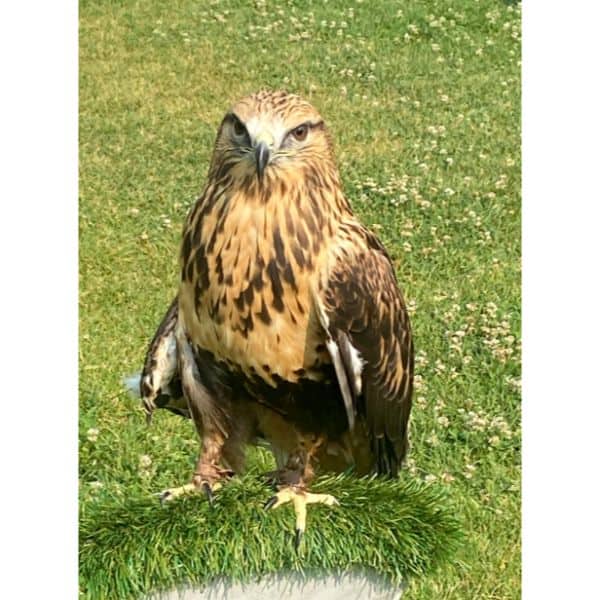
Rough-legged Hawk Characteristics:
- Scientific Name: Buteo Lagopus
- Length: 18.5-20.5 in (47-52 cm)
- Weight: 25.2-49.4 oz (715-1400 g)
- Wingspan: 52.0-54.3 in (132-138 cm)
The Rough-legged Hawk is spotted in Kansas throughout the year. However, your best bet to spot one of these hawks is during the winter.
The hawk has a mottled dark and light plumage with big, dark patches on the wrists.
It has a light tail with a well-defined, dark band, and the feathers on its upper parts are reddish-brown or sepia with orange-brown edges.
The underparts of a rough-legged hawk are streaky with barring on its legs.
The Rough-legged hawk has a diverse diet; it consumes small rodents, such as moles, during the breeding season and small mammals, such as mice and voles, during the winter.
Large mammals such as rabbits also comprise a small portion of their diet.
Its call is similar to a Red-shouldered Hawk’s; the Rough-legged Hawk gives out a kee-err sound, sounding almost like a downward slurring whistle.
This sound lasts about 1 second and is repeated 15-30 seconds when the bird is either alarmed or feels an intruder approaching its nesting site.
They usually breed in tundra and taigas but also inhibit marshes, prairies, and fields.
4. Sharp-Shinned Hawk
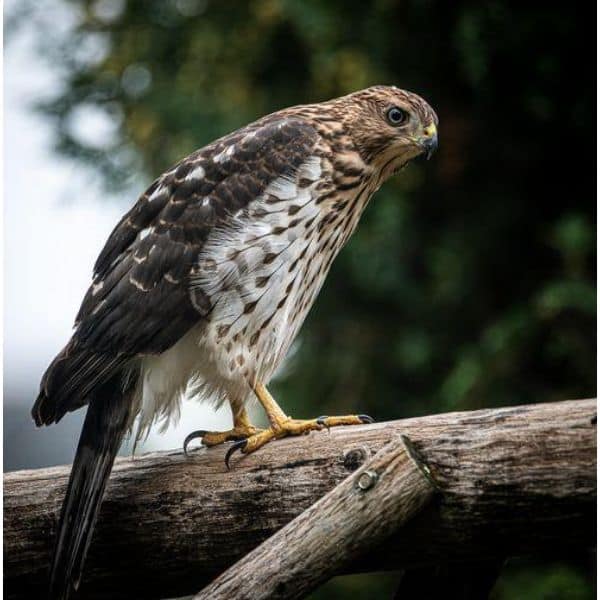
Sharp-shinned Hawk Characteristics:
- Scientific Name: Accipiter Striatus
- Length: 9.4-13.4 in (24-34 cm)
- Weight: 3.1-7.7 oz (87-218 g)
- Wingspan: 16.9-22.1 in (43-56 cm)
Sharp-shinned Hawks are found in Kansas between September to May.
One of the smallest hawks in the United States, the Sharp-shinned Hawk, weighs around 82-218g.
It is colored gray from above with light orange bars on its body from the bottom.
The tail is long with alternately dark and light gray bands, whereas the wings are short and rounded. The Sharp-shinned Hawk’s throat is white, and its head is round.
Its diet primarily consists of small to medium-sized birds like sparrows, wrens, and finches.
However, it also consumes small mammals like rodents, bats, frogs, snakes, lizards, and other large insects.
The Sharp-Shinned Hawk’s call is a high-pitched “kik-kik-kik” or “kek-kek-kek”.
Although it’s usually a silent bird, it can be vocal when alarmed or during the breeding season.
This hawk commonly inhibits lowlands and high montane forests.
They usually nest under dense forest cover or deciduous trees. However, it avoids open country during the winter and is only found in bushy or forest-like areas when the cold hits.
5. Northern Harrier

Northern Harrier Characteristics:
- Scientific Name: Circus cyaneus
- Length: 18.1-19.7 in (46-50 cm)
- Weight: 10.6-26.5 oz (300-750 g)
- Wingspan: 40.2-46.5 in (102-118 cm)
Northern Harriers are found in southwestern Kansas.
A medium-sized bird of prey, the Northern Harrier has a mesmerizing plumage pattern; it has a gray-brown colored back with light gray undersides and pale white croup.
The head is gray and has a white patch surrounding its bill. The wings are broad, and its tail is rounded yet long.
The Northern Harrier is compared to an owl due to its facial disk, similar to an Owl’s.
If you want to identify a Northern Harrier in the air, note that this gorgeous bird flies with its broad wings held in a V-like shape.
95% of a Northern Harrier’s diet comprises small mammals such as ground squirrels, rats, and voles.
But this hawk can also hunt for small birds such as larks, sparrows, and tiny shorebirds. If small mammals and birds are scarce, the Northern Harrier can also happily consume reptiles like frogs.
When a Northern Harrier feels threatened by an intruder or a predator, it uses high-pitched “kek” sounds or a sharp whistle.
Mostly found in different kinds of open terrain, Northern Harriers prefer wet and dry habitats. They nest in marshes, dry open fields, prairie grasslands, and fields.
6. Northern Saw-Whet Owl
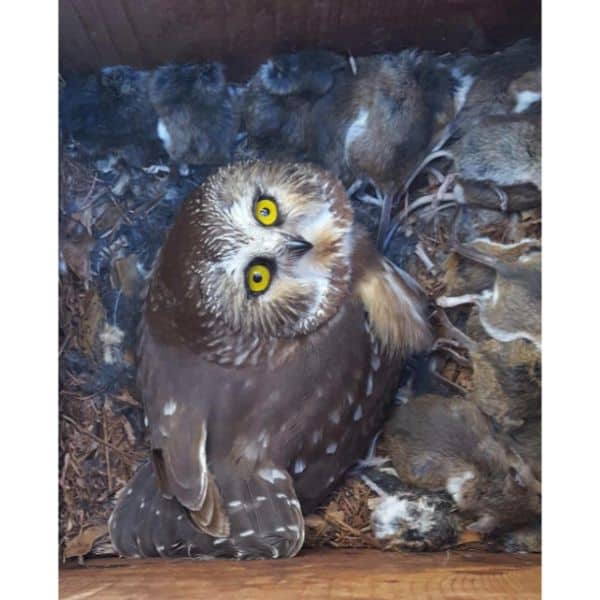
Northern Saw-whet Owl Characteristics:
- Scientific Name: Aegolius acadicus
- Length: 7.1-8.3 in (18-21 cm)
- Weight: 2.3-5.3 oz (65-151 g)
- Wingspan: 16.5-18.9 in (42-48 cm)
One of the smallest owls of the owl kingdom and the smallest among birds of prey in Kansas is the Northern Saw-whet Owl.
The Northern Saw-whet Owl has a large, rounded, and buff-colored face with cream and brown streaks and no ear tufts. Its beak is dark, and the eyes are yellow.
Its underparts are pale with dark-colored areas, and the upperparts are brown with white patches.
The Northern Saw-whet owl is fond of consuming small mammals, which comprise a significant portion of their diet.
These small mammals include small rodents, mice, and deer mice. Apart from small mammals, they also hunt small birds, such as sparrows and swallows.
Its call consists of sounds, including squeaks, whines, high-pitched barks, and a “toot-toot-toot” sound during the breeding season.
Northern Saw-whet owls inhibit mixed and deciduous forests, coniferous forests, usually in the winter, and marshes, open fields, marshes, and grasslands.
7. Barred Owl

Barred Owl Characteristics:
- Scientific Name: Strix Varia
- Length: 12.6-15.8 in (32-40 cm)
- Weight: 14.1-24.7 oz (400-700 g)
- Wingspan: 39.4-49.2 in (100-125 cm)
One of the most common Kansas owls, the Barred Owl, is a large owl with a big, rounded head that is heart-shaped.
However, it has no ear-tufts, similar to the Northern Saw-whet Owl.
Its face is light gray with a yellow beak, and the upper parts are brown-shaded with mottling. The tail is long, dark brown, with white bars.
The Barred Owl feeds on mammals, such as voles, mice, and rodents. However, it also devours birds, reptiles, amphibians, fish, and earthworms.
A Barred Owl can easily be identified by its hooting call; you can find this precious bird by looking out for a barking ”Who cooks for you?” ”Who cooks for you?” call.
From afar, a Barred Owl can also sound like a dog. Moreover, this owl is easier to spot at night when it is extremely active.
Barred Owls usually inhibit wooded river bottoms, swamps, nearby water bodies, and old mixed and deciduous forests.
8. Barn Owl

Barn Owl Characteristics:
- Scientific Name: Tyto Furcata
- Length: 12.6-15.8 in (32-40 cm)
- Weight: 14.1-24.7 oz (400-700 g)
- Wingspan: 39.4-49.2 in (100-125 cm)
Being non-migratory birds, the Barn Owl is a year-round Kansas resident.
The Barn Owl has a rounded, heart-shaped face without ear tufts. It has grayish upperparts and rufous to buff shaded underparts with dark spots.
The tail is short with light brown feathers and broad and rounded wings.
Similar to other owls, the Barn Owl’s diet consists of small mammals, usually rodents, rabbits, bats, and rodents.
However, they are a summer favorite for the Barn Owl and are mostly consumed during the summer. However, it can also devour skinks, snakes, frogs, and geckos.
Barn Owls can be identified by their unique calls; they do not usually hoot like other owls.
Instead, they make long, harsh shrieks that last about 2 seconds. Its call is often defined as a ”perennial screech”.
Barn Owls place their nests in holes in trees, caves, cliff ledges, and farmlands and can also be found in cities.
9. Eastern Screech-Owl

Eastern Screech Owl Characteristics:
- Scientific Name: Megascops Asio
- Length: 6.3-9.8 in (16-25 cm)
- Weight: 4.3-8.6 oz (121-244 g)
- Wingspan: 18.9-24.0 in (48-61 cm)
Eastern Screech-owls are commonly found on the west edge of Kansas.
The Eastern Screech-Owl’s body can be gray or reddish-brown with vermiculated underparts.
Either way, the body has dark streaking with rounded wings and a short, square-shaped tail.
The Eastern Screech owl has a large head and prominent ear tufts, especially when they’re raised.
The Eastern Screech owl feeds on mammals, birds, earthworms, insects, and lizards.
They have a significant variety in their diet and mostly consume large insects and small rodents. This owl’s favorite food is beetles, crickets, and moths.
Pay attention to a noise resembling an even-pitched trill to identify an Eastern Screech owl.
Mates use this sound during the breeding season to communicate. Another sound commonly made by the Eastern Screech owl is a high-pitched whine sound.
Eastern Screech Owls inhibit mixed and deciduous forests, woodlands, wooded suburban areas, and wetlands.
10. American Kestrel

American Kestrel Characteristics:
- Scientific Name: Falco sparverius
- Length: 8.7-12.2 in (22-31cm)
- Weight: 3-6 oz (85-170 g)
- Wingspan: 9-12 in (51-61 cm)
American Kestrels are found year-round residents of Kansas.
The American Kestrel, the smallest falcon in the United States, weighs around 120g. It is a slim bird with pointed, long but narrow wings and a long tail.
The tail is rufous colored with black bars. Overall, an American Kestrel’s body is pale from below and black with rusty brown spots from the front.
The wings are blue-ish for males and rufous for their female counterparts.
It mostly prefers small insects and mammals for food. Its diet mostly consists of beetles, cicadas, butterflies, moths, and dragonflies. However, they can also eat voles and mice.
American Kestrels communicate with one another using three distinctive sounds; the sounds include a “klee” or “killy,” the “whine,” or the “chitter.”
The “Klee” sound often displays the bird’s distress or excitement; the ”whine” is often associated with feeding, whereas the ”chitter” is used during mating or courtship.
American Kestrels often inhibit meadows, grasslands, urban areas, and agricultural lands.
11. Merlin

Merlin Characteristics:
- Scientific Name: Falco columbarius
- Length: 9.4-11.8 in (24-30 cm)
- Weight: 5.6-8.5 oz (160-240 g)
- Wingspan: 20.9-26.8 in (53-68 cm)
Since the Merlin is a migratory bird, it can be found in Kansas only during spring and fall migration.
A heavy-built bird, Merlins are dark-colored birds with streaky bodies. They’re generally light to dark gray with dark underwings and cream underparts.
The wings are sharp, and the tail is medium in length.
A Merlin’s favorite meal consists of small to medium-sized birds.
Usually, larks, quails, and sparrows. However, it can also eat large insects and small mammals such as bats and rodents.
Merlins give out a similar call, whether in courtship or aggression; the sound chatty, shrill-like call.
If you want to spot a Merlin in Kansas, you must head to nearby coastlines or any open country.
12. The Harpy’s Eagle
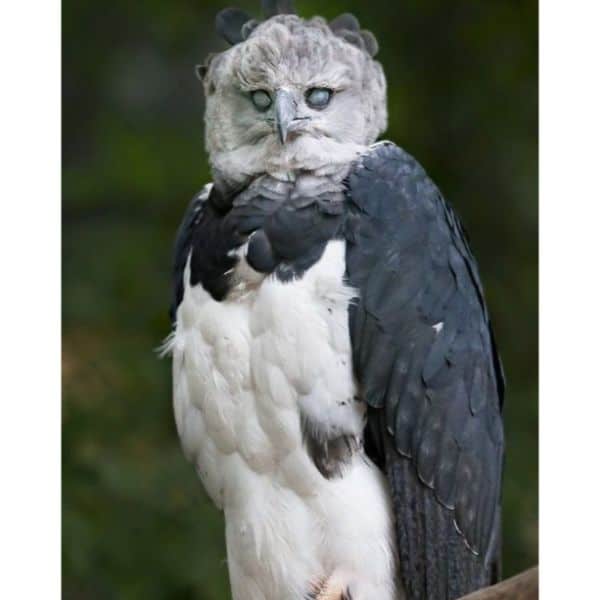
The Harpy’s Eagle Characteristics:
- Scientific Name: Harpia harpyja
- Length: 36-40 in (99 cm)
- Weight: 1.4-7.2 kg
- Wingspan: 5 ft 9 in-7ft 4 in (176-224cm)
Although uncommon, the Harpy’s Eagle has been spotted in Kansas.
The Harpy’s Eagle is covered with gray-blue and black feathers, with its underside being white-shaded.
It can be identified by the fan of gray feathers on the top of its head and a banded, black-colored plumage that stretches its neck.
The bill and cere of a Harpy’s Eagle are black, and its toes are yellow.
The Harpy’s Eagle diet consists largely of mammals; opossums, sloths, and some monkey species are an all-time favorite, along with porcupines, squirrels, and opossums.
Its call resembles a whistle or loud, piping whistle and appears as a “whee-whee-whee” sound.
Tall trees in forests are the common habitat for nesting. It generally prefers lowland and tropical forests as habitats.
13. Golden Eagle
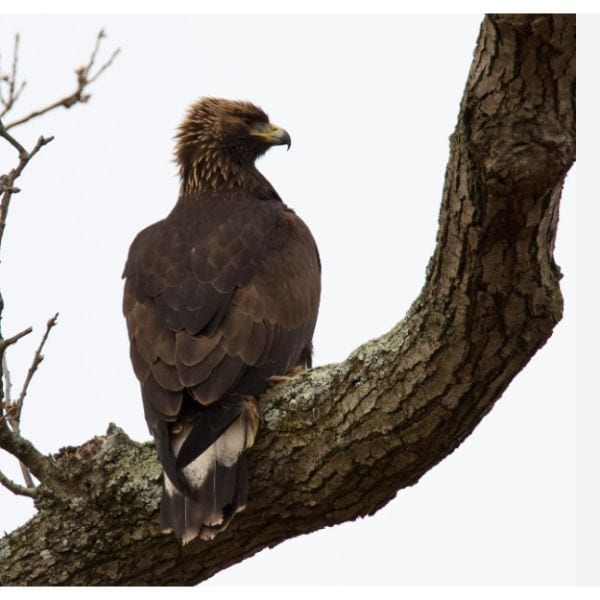
Golden Eagle Characteristics:
- Scientific Name: Aquila chrysaetos
- Length: 27.6-33.1 in (70-84 cm)
- Weight: 105.8-216.1 oz (3000-6125 g)
- Wingspan: 72.8-86.6 in (185-220 cm)
The last on our list of birds of prey in Kansas is the Golden Eagle. One of the most common eagles found in Kansas, the Golden Eagle, is located in the state year-round.
The Golden Eagle has a dark-brown plumage with a golden blonde shade behind the head.
The base of its tail is covered with white feathers, and its beak and claws are black. The cere and feet of a Golden Eagle, however, are yellow.
A Golden Eagle prefers consuming small mammals, including prairie dogs, rabbits, marmots, and ground squirrels.
However, it can also occasionally eat birds, reptiles, and fish.
The eagle’s call is weak, whistled, and high, especially during breeding.
However, a wonk-like sound is associated with feeding, usually to announce food deliveries.
You can look for this mesmerizing bird near and in scrublands, grasslands, woodlands, and rangelands.
All Birds of Prey in Kansas
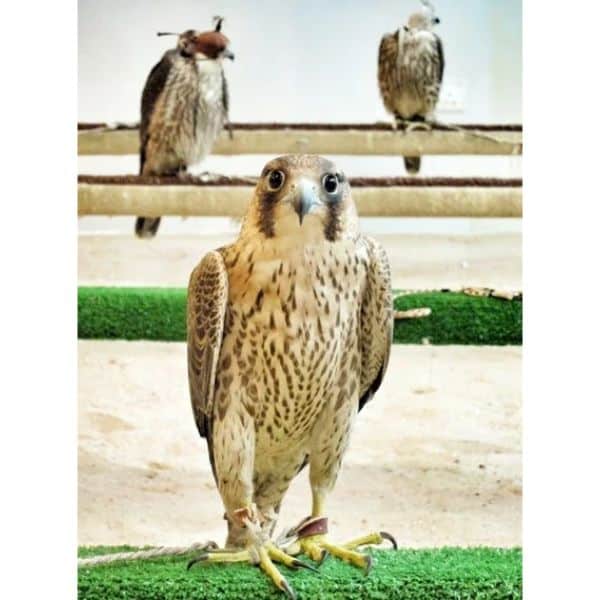
The Sunflower State of Kansas is truly the ideal spot to go birdwatching. Kansas has recorded a total of 473 bird species in the state, including several species of birds of prey.
Moreover, the state has several spots that offer excellent opportunities to visit for birdwatching.
These include Cheyenne Bottoms Wildlife Area, Shawnee Mission Park, Perry Lake, Quivira National Wildlife Refuge, and Baker University Wetlands.
If you find this guide, “All Birds of Prey in Kansas,” informative and helpful, you can check out these other bird-related articles from our team:
- Why Do Birds Fly in Circles?
- Why Do Birds Throw Babies Out of the Nest?
- Why Do Birds Stand on One Leg?
You can learn more about birds by watching “Things You Should Be Told Before Getting a Hawk” down below:

